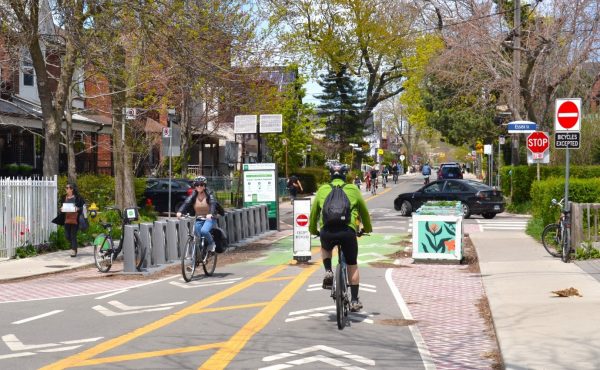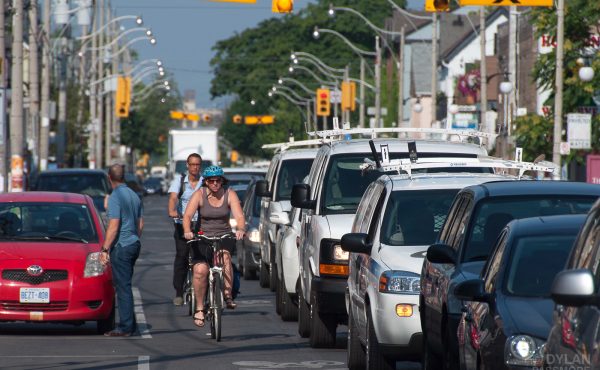Much has happened for cycling in Vancouver since I left a year and a half ago. With new separated lanes, Vancouver has created the back-bone of what is hoped to become a robust downtown network. When I left, the city had just completed separated lanes on the Dunsmuir viaduct—a piece of leftover infrastructure for the downtown highway that never materialized. Then came the ones on Dunsmuir Street and Hornby Street—allowing cyclists to ride through the downtown core completely in separated lanes.
Going back to Vancouver this summer, I found myself riding many of the streets on which I learned how to be an “urban” cyclist. I had biked when I was younger, but it was of the, “OK kids let’s throw the mountain bikes on the car and go drive to some trails” variety. As anyone who has made the jump from riding in the forest to riding on the roads can tell you, there is a bit of a learning curve. Now I had to worry about things like stop lights and pedestrians. Oh, and all those pesky cars.
Luckily, Vancouver is a pretty hospitable environment for the junior urban cyclist. I learned how to navigate my way through the city first on 10th Avenue, the bicycle boulevard that stretches across the city, parallel to Broadway Street, as well as riding the almost ridiculously pleasant seawall that loops its way around much of the downtown core and Stanley Park. Then I tried my hand at the on-street bike lanes of which there are 400km of (and counting) criss-crossing the city. Finally, I made my way onto the actual streets, which, thanks to much milder winters than Toronto’s, are smooth riding.
One of the biggest pluses of biking Vancouver is that the city is constantly improving the network to make cycling easier and safer. This doesn’t mean simply painting bike lanes. This means easily spotted signage that helps you navigate. Light changers that are bumped out to the curb for cyclists. Green paint through intersections, which alerts drivers that this is a bike crossing. Bike boxes throughout the city to help cyclists turn at intersections. And a cycling map that folds up into a handy business-card size.
UBC has even launched a cycling route planner where you can choose between getting the most direct route or one that uses only bike lanes. There is room for improvement in Vancouver’s cycling network, but the focus on connecting lanes and making it easily navigable has paid off. The separated lanes in the downtown, for example, connect with multiple painted lanes, meaning they aren’t simply a segregated conduit through the downtown core, but connect you to bike lanes going elsewhere.
The lanes are also allowing more people to ride their bikes downtown than before. Not only have the numbers of cyclists on those streets risen (which could just be due to people changing their routes to use the lanes), but the number of women and children biking is also increasing [PDF]. On an anecdotal level, I spoke with two friends in Vancouver who were once too timid to ride downtown, but were now riding in the separated lanes. (Check out this video from Spacing Vancouver to see what the lanes look like in action.)
Of course, the separated lanes are not without controversy, with drivers claiming traffic is backed up and businesses claiming sales have dropped. Two reports by the City of Vancouver dispute those claims, however, showing that travel time on the roads have barely increased and that the economic impact on businesses is marginal.
There are some things with which Vancouver struggles; namely, bike parking. Wherefore art thou post-and-ring? Visiting a friend in the West End left me walking three blocks to Davie Street to lock up outside of a grocery store. It’s mind-boggling that there are so few places to park in an area with such a high density of people. If Vancouver is truly to become the bike mecca it wants to be, they need to address the issue of where to park—and fast. Vancouver is attempting this with their “Bike Vancouver” racks, but they are far from numerous. Score one for Toronto.
Another score for Toronto is Bixi. Vancouver doesn’t have bike share. Yet. The City has been looking at implementing a bike share program, and plans are underway to have the system up and running just in time for Vancouver to play host to the VeloCity 2012 international biking conference in June. Part of the reason there has been a delay in getting a bike share program up and running in the city is the law that requires all cyclists, regardless of age, to wear helmets.
Without diving into that debate, this makes it difficult for a bike share program, which relies on people being able to just jump on a bike wherever they may be, to be viable. Melbourne, Australia is an example of a city with a mandatory helmet law that has a bike share program. They offer helmets at numerous locations around the city for $5, and, if you return the helmet, you get $3 back. However, the lacklustre showing of Melbourne’s bike share program is leading some to criticize the mandatory helmet law as a hindrance.
And then there’s politics. Vancouver has just ten councillors plus a mayor, presiding over a much smaller geographical area and population than Toronto. Each councillor is elected at-large, which means they’re responsible for the whole city. Vancouver’s municipal system also involves parties, with the Vision Vancouver dominated City Council finding it pretty easy to push through policies they put forward (like bike lanes).
However, the political culture in Vancouver leans more favourably towards cycling in Vancouver than in Toronto anyway. In the 2008 municipal election, both mayoral candidates, Vision’s Gregor Robertson and the NPA’s Peter Ladner, came out in support of cycling. Frequently the choice in Vancouver politics is between those that support cycling and those that really support cycling. As another municipal election looms, it remains to be seen whether NPA mayoral candidate Suzanne Anton, who recently hired the election campaign firm that Rob Ford used, will attempt to spin some lingering discontent over the separated bike lanes to stir up support. However, even Anton voted in favour of the Hornby separated lane (although she later rescinded her vote). Oh, Vancouver.
photo by the author





5 comments
Envy those cyclists in Vancouver, better infrastructure all around, and when they starts bike sharing it will probably surpass the lackluster Toronto Bixi in a heartbeat. Well, except for that silly mandatory helmet law, get rid of it already! (For the record I wear my helmet most of the time, but that is a choice). But I actually prefer Toronto’s cold and dry winter rides to the wet Vancouver winter.
i’ve been cycling in toronto for ten years, and just tried out vancouver’s separated bike lanes and waterfront trails in august. it was heavenly.
Good article. One little thing: Vancouver’s roads aren’t just in better shape because of the climate, they’re in better shape because the city has a much more coordinated road repair system. In Toronto, roads are constantly being ripped up and hastily repaved because utilities cannot coordinate schedules. This leads to the cracks and ruts in the road surface, and also leads to the inevitable lane closures that probably contribute far more to traffic congestion than any bike lane or streetcar.
And New York just voted to add miles more separated bike lanes through midtown Manhattan. And LA and Chicago have opened their lanes recently. You can’t stop this movement – it’s everywhere.
Everywhere except for one place…
Toronto, you’re being left behind in your pretty Bixi dress while everyone else goes to the ball. But, that’s what you get for being Rob Ford’s girlfriend, huh.
Putting bike paths in hydro corridors and ravines are fine, but bicyclists have to get To and FROM the bike path. Just have the councillors try to travel on the 60 km/h roads to get there, and are of course forbidden to use the sidewalks, They might recommend using the maze of side streets, but going around in circles and getting lost is not nice.